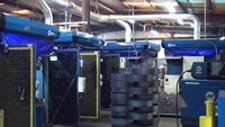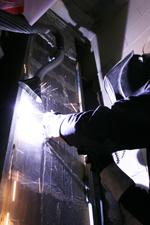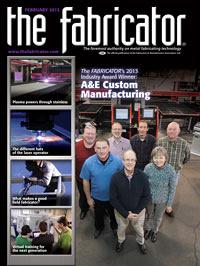Product Manager
- FMA
- The Fabricator
- FABTECH
- Canadian Metalworking
Categories
- Additive Manufacturing
- Aluminum Welding
- Arc Welding
- Assembly and Joining
- Automation and Robotics
- Bending and Forming
- Consumables
- Cutting and Weld Prep
- Electric Vehicles
- En Español
- Finishing
- Hydroforming
- Laser Cutting
- Laser Welding
- Machining
- Manufacturing Software
- Materials Handling
- Metals/Materials
- Oxyfuel Cutting
- Plasma Cutting
- Power Tools
- Punching and Other Holemaking
- Roll Forming
- Safety
- Sawing
- Shearing
- Shop Management
- Testing and Measuring
- Tube and Pipe Fabrication
- Tube and Pipe Production
- Waterjet Cutting
Industry Directory
Webcasts
Podcasts
FAB 40
Advertise
Subscribe
Account Login
Search
A road map for managing welding fume
Welding process changes, engineering controls, and PPE all play a role
- By Al Hilbert
- February 15, 2013
- Article
- Safety

Figure 1: Implementing-source capture systems that immediately remove fume, as shown here, may eliminate the need for equpment such as personal respirators.
Each welding operation has a different reason for weld fume management. Some companies have tested their environment and have particulate saturation above the permissible exposure limit (PEL) deemed acceptable by OSHA. Others simply want to limit the amount of particulate in the air for employee well-being.
The steps each company takes are different, but they have a number of elements in common. Proc-ess and behavioral changes should be the first step, but are not always feasible because of weld requirements and specific processes involved. If this is the case, engineering controls as well as personal protective equipment (PPE) come into play.
Note that every welding environment is unique and should be evaluated by a qualified industrial hygienist to determine the appropriate course of action for fume control. This article is presented for awareness and educational purposes only and should not replace professional consultation.
Work the Process
Before implementing any engineering or mechanical controls, first consider changes to the welding process itself. These may include:
- Using different base materials
- Enclosing the welding processes
- Switching wire types (changing from a flux-cored wire to a solid wire, for instance)
- Changing the welding process (from shielded metal arc to gas metal arc welding, for example)
- Choosing different transfer methods (from short-circuit or globular transfer to spray or pulsed GMAW, for example)
- Changing deposition rates or weld settings
- Altering welder behavior
Before implementing any of these, you must examine each thoroughly in the context of your welding application. Some will require testing and certification to ensure welding tolerances are maintained, and others may require process recertification.
You may be able to make some changes immediately, depending on the situation. For instance, weld fumes rise, so welders shouldn’t position themselves directly above the weld. Whenever possible, they should position the weld away from them. They also should never stand behind a fan and then weld. As that fan moves air, it will move welding fume right through their breathing zone.
Engineering Controls
After you evaluate the process, the next step is to reduce exposure via fume extraction. Industrial ambient or push/pull ventilation systems are designed to protect the whole shop, which is important if other workers are in close proximity to the welding activity.
However, such systems can be inefficient at removing particulate, especially in buildings with tall ceilings. They do not protect the welder’s immediate breathing zone, and they can be expensive to implement, often requiring changes to the building. And while weld fumes naturally rise, they eventually level out and descend to the surface.
Unlike ambient ventilation, source-capture devices remove contaminated air at the source before it reaches a worker’s breathing zone, which is why such systems often are the best method for weld fume control (see Figure 1). These devices can be portable, stationary, wall-mounted, or part of a centralized industrial system (see Figures 2 and 3). They can have traditional hoods or, as with fume guns, be integrated with the welding torch.
All are rated based on the amount of cubic feet of air they extract each minute (cubic feet per minute, or CFM). Each manufacturer rates CFM differently, which is why CFM should be tested at the hood to determine the system’s true rating.

Figure 2: Fume hoods matched with robotic cells help protect the entire working environment from airborne particulate.
Filter cleaning is another factor. Some filtration systems have disposable filters; others have manual cleaning, self-cleaning, or automated/online cleaning functions. Compared to disposable filter systems, self-cleaning and automated models cost more upfront but ultimately may be more cost-effective over time, especially when you factor in the cost of disposable filters.
Source-capture systems are classified either as low-vacuum/high-volume or high-vacuum/low-volume. Low-vacuum/high-volume systems process a large volume of air but at generally low vacuum pressures. They are like the HVAC system in your house, which has large ducting that handles high volumes of air. These source-capture devices have a longer capture distance, meaning they can capture fumes effectively at a greater distance from the actual welding process.
High-vacuum/low-volume systems, on the other hand, have much shorter capture distances and so need to be placed close to the actual welding. High-vacuum action typically occurs through a fume extraction gun or a small attachment such as a nozzle. The airflow in these systems is more like that in a vacuum cleaner. Many have small hoses and ducting that are ideal for removing fume from welding in confined spaces.
Respiratory Options
Source capture may not be an optimal choice in all situations, such as for large weldments or in areas with obstructions where it is not practical or possible to have an extraction hood or attachment right at the weld at all times. Constantly moving hoods and attachments around large, complicated parts may not be physically possible.
If you are not able to get the PEL below acceptable levels with process changes or source capture, the application may require welders to wear respiratory devices. To determine the proper respiratory option, first calculate the maximum use concentration, or MUC, by multiplying the material’s PEL by the respirator’s assigned protection factor, or APF. If the resulting number is higher than the particulate concentration found during testing, the respiratory device will suffice.
For example, after implementing process and engineering controls, you test the facility and find it has a hexavalent chromium rating of 65 µg/m3. This means you will need a device with an MUC exceeding that number. Multiply the PEL of hexavalent chromium (5 µg/m3) by the APF of the respiratory device (25) to get an MUC of 125 µg/m3. This indicates the device will protect the welder adequately in this environment. (This example is hypothetical. As stressed previously, the information in this article is for informational purposes only. It is critical to work through this with a certified industrial hygienist.)
Respiratory device options include powered air purifying respirators (PAPRs), half-masks, and supplied-air respirators. For welder comfort, try choosing a lightweight PAPR that evenly distributes the weight via strategically placed shoulder straps or other methods. If you choose a half-mask, be sure that it fits easily under welders’ helmets.
Supplied-air respirators provide clean air from an uncontaminated source and are used when welders do not need to be very mobile. Some units heat or cool welders as well. Supplied-air respirators have APFs from 25 to 1,000, depending on the unit and head assembly.
Why Fume Extraction Matters
Weld fume extraction and employee safety do not have to be complicated. Working with a certified industrial hygienist to determine the best way to mitigate welding fumes is critical for working in a healthy environment. This will help welding operations meet safety requirements and keep welders happy and feeling good about coming to work every day — essential for productivity and quality.
Resources

Figure 3: Small, portable systems are beneficial for construction applications and other remote welding activities without built-in welding stations.
Assigned Protection Factors for the Revised Respiratory Protection Standard, Occupational Safety and Health Administration, 2009, http://www.osha.gov/Publications/3352-APF-respirators.pdf
AWS/ANSI Z49.1:2005, Safety in Welding, Cutting, and Allied Processes, American Welding Society, 2005, http://www.aws.org/technical/facts/Z49.1-2005-all.pdf
MERV Factors
All weld fume extraction equipment filters should have a minimum efficiency reporting value (MERV). Many are not designed to handle submicron particles found in welding fumes; 95 percent of weld fume particulates are 0.3 to 1 micron.
Filters with MERV ratings of 15 and 16 immediately capture up to 95 percent of submicron particles found in welding fumes. Standard cellulose filters rate 7 to 10 on the MERV scale, which means they are not rated to capture particles smaller than 1 micron. Spunbond polyester filter material, which has a MERV rating of 11, also is not very efficient at capturing particles smaller than 1 micron.
About the Author
Al Hilbert
1635 W. Spencer St. P.O. Box 1079
Appleton, WI 54912
800-426-4553
Related Companies
subscribe now

The Fabricator is North America's leading magazine for the metal forming and fabricating industry. The magazine delivers the news, technical articles, and case histories that enable fabricators to do their jobs more efficiently. The Fabricator has served the industry since 1970.
start your free subscription- Stay connected from anywhere

Easily access valuable industry resources now with full access to the digital edition of The Fabricator.

Easily access valuable industry resources now with full access to the digital edition of The Welder.

Easily access valuable industry resources now with full access to the digital edition of The Tube and Pipe Journal.
- Podcasting
- Podcast:
- The Fabricator Podcast
- Published:
- 04/16/2024
- Running Time:
- 63:29
In this episode of The Fabricator Podcast, Caleb Chamberlain, co-founder and CEO of OSH Cut, discusses his company’s...
- Trending Articles
Capturing, recording equipment inspection data for FMEA

Tips for creating sheet metal tubes with perforations

Are two heads better than one in fiber laser cutting?

Supporting the metal fabricating industry through FMA

Hypertherm Associates implements Rapyuta Robotics AMRs in warehouse

- Industry Events
16th Annual Safety Conference
- April 30 - May 1, 2024
- Elgin,
Pipe and Tube Conference
- May 21 - 22, 2024
- Omaha, NE
World-Class Roll Forming Workshop
- June 5 - 6, 2024
- Louisville, KY
Advanced Laser Application Workshop
- June 25 - 27, 2024
- Novi, MI


























